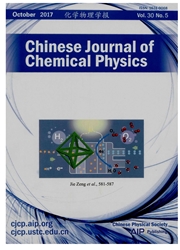

 中文摘要:
中文摘要:
白器官的轻射出的二极管被使用新奇磷光二度( 1,2-dipheny1-1H-benzoimidazole )制作铱( acetylacetonate )[( pbi ) 2红外(交流交流)]作为 sensitizer 和4-( dicyanomethylene )的荧光灯的染料, -2-t-butyl-6-(1,1,7,7-tetramethyljulolidyl-9-enyl)-4H-pyran ( DCJTB )鳕鱼打开了进 car-bazole 聚合物 poly ( N-vinylcarbazole )( PVK )。通过描绘紫外力的吸收系列,光致发光系列(pbi )2 红外(交流交流) 和 DCJTB,和电镀物品光光谱 WOLED 的性质,鳕鱼的精力转移机制打开了聚合物系统被推出。结果证明有不同紧张的光系列(pbi )2 红外(交流交流) 和 DCJTB 在混合系统的 EL 系列是共存的,它在 EL 进程被归功于到不完全的精力转移进程。在主人和客人之间的有效 Förster 和右边的精力转移启用了强壮的黄排出物从(pbi )2 红外(交流交流) 和 DCJTB,在此(pbi )2 红外(交流交流) 为 DCJTB 作为发磷光的 sensitizer 起一个重要作用。与 N 的蓝发射极层, N'-diphenyl-N, N'-bis (1-naphthyl )(1,1'-biphenyl )-4,4'-diamine, 鳕鱼打开了系统设备完成的白排放。鳕鱼打开了系统证明它的委员会共产国际歌 de 1'Eclairage 坐标比发磷光的做的 PVK 系统的那些更独立于偏爱电压的变化。
 英文摘要:
英文摘要:
White organic light-emitting diodes were fabricated by using a novel phosphorescence bis(1,2-diphenyl-1H-benzoimidazole)iridium(acetylacetonate)[(pbi)2Ir(acac)] as sensitizer and a fluorescent dye of 4- (dicyanomethylene)-2-t-butyl-6-(1,1,7,7-tetramethyljulolidyl-9-enyl)-4H-pyran (DCJTB) codoped into a carbazole polymer of poly(N-vinylcarbazole) (PVK). Through characterizing the UV-Vis absorption spectra, the photoluminescence spectra of (pbi)2Ir(acac) and DCJTB, and the electroluminescence spectral properties of the WOLEDs, the energy transfer mechanisms of the codoped polymer system were deduced. The results demonstrate that the luminescent spectra with different intensity of (pbi)2Ir(acac) and DCJTB were co-existent in the EL spectra of the blended system, which is ascribed to an incomplete energy transfer process in the EL process. The efficient Forster and Dexter energy transfer between the host and the guests enabled a strong yellow emission from (pbi)2Ir(acac) and DCJTB, where (pbi)2Ir(acac) plays an important role as a phosphorescent sensitizer for DCJTB. With the blue emitting-layer of N,N'-diphenyl-N,N'-bis(1- naphthyl)(1,1'-biphenyl)-4,4'-diamine, the codoped system device achieved white emission. The codoped system showed that its Commissions Internationale de 1'Eclairage coordinates were more independent of the variation of bias voltage than those of phosphorescent doped PVK systems.
 同期刊论文项目
同期刊论文项目
 同项目期刊论文
同项目期刊论文
 Study?on?temperature?characteristics?of?organic?light-emitting?diodes?based?on?tris-(8-hydroxylquino
Study?on?temperature?characteristics?of?organic?light-emitting?diodes?based?on?tris-(8-hydroxylquino Efficient Blue Organic Light-emitting Diodes with Simple Structure Based on N,N'-bis(1-naphthy)-N,N'
Efficient Blue Organic Light-emitting Diodes with Simple Structure Based on N,N'-bis(1-naphthy)-N,N' Efficient white organic light-emitting devices using a thin 4,4'-bis(2,2'-diphenylvinyl)-1,1'-diphen
Efficient white organic light-emitting devices using a thin 4,4'-bis(2,2'-diphenylvinyl)-1,1'-diphen Self-assembly of Tio2/polypyrrole nanocomposite ultrathin films and application for an NH3 gas senso
Self-assembly of Tio2/polypyrrole nanocomposite ultrathin films and application for an NH3 gas senso Luminescent Enhancement of Heterostructure Organic Light-Emitting Devices Based on Aluminum Quinolin
Luminescent Enhancement of Heterostructure Organic Light-Emitting Devices Based on Aluminum Quinolin Influences of fluorine auxochrome in fluorene molecular electroluminescent material on optoelectroni
Influences of fluorine auxochrome in fluorene molecular electroluminescent material on optoelectroni Efficient bright white organic light-emitting diode based on non-doped ultrathin 5,6,11,12-tetraphen
Efficient bright white organic light-emitting diode based on non-doped ultrathin 5,6,11,12-tetraphen Fabrication and nonlinear optical properties of polymeric thin films doped with a novel tricyanofura
Fabrication and nonlinear optical properties of polymeric thin films doped with a novel tricyanofura Low roll-off power efficiency of organic light-emitting diodes consisted of nondoped ultrathin phosp
Low roll-off power efficiency of organic light-emitting diodes consisted of nondoped ultrathin phosp X-ray photoelectron spectroscopy characterization of the interface between Ag electrode and PVDF fil
X-ray photoelectron spectroscopy characterization of the interface between Ag electrode and PVDF fil Spectral Characteristics of White Organic Light-emitting Diodes Based on Novel Phosphorescent Sensit
Spectral Characteristics of White Organic Light-emitting Diodes Based on Novel Phosphorescent Sensit Color-tunable organic light-emitting devices using a thin N,N prime -bis-(1-naphthyl)-N,N prime -dip
Color-tunable organic light-emitting devices using a thin N,N prime -bis-(1-naphthyl)-N,N prime -dip Electron irradiation effects on the properties of heavily phosphorus-doped a-Si ,H films prepared fr
Electron irradiation effects on the properties of heavily phosphorus-doped a-Si ,H films prepared fr Efficeng small molecular and polymer organic devices using bis[2-(4-tert-butylpheny)benzothiazolato-
Efficeng small molecular and polymer organic devices using bis[2-(4-tert-butylpheny)benzothiazolato- Study on tempeature characteristica of organic light-emitting diodes based on tris-(8-hydrocylquinol
Study on tempeature characteristica of organic light-emitting diodes based on tris-(8-hydrocylquinol Influence of PVK: NPB hole transporting layer on the charcateristics of organic light-emitting devic
Influence of PVK: NPB hole transporting layer on the charcateristics of organic light-emitting devic Conducting polymericnanoparticles synthesized in reverse micelles and their gas sensitivity based on
Conducting polymericnanoparticles synthesized in reverse micelles and their gas sensitivity based on Low energy emission bands in a small molecular fluorene derivative for organic light-emitting dioeds
Low energy emission bands in a small molecular fluorene derivative for organic light-emitting dioeds Fiexible organic light-emitting diodes with improved performance by insertion of an UV-sensitive lay
Fiexible organic light-emitting diodes with improved performance by insertion of an UV-sensitive lay 期刊信息
期刊信息
